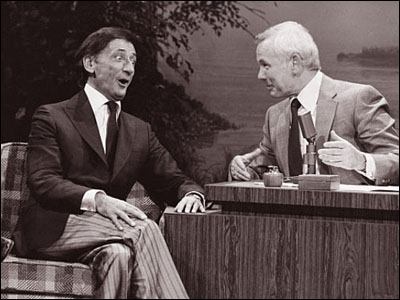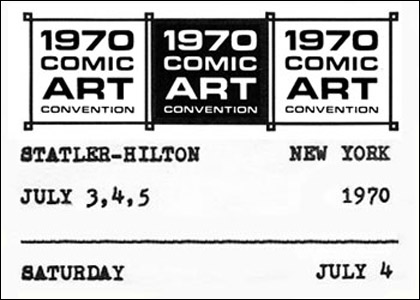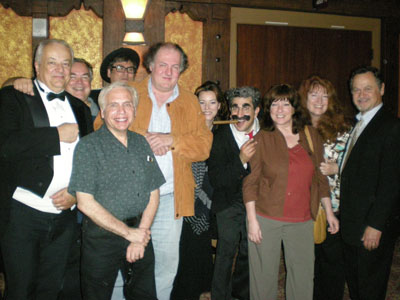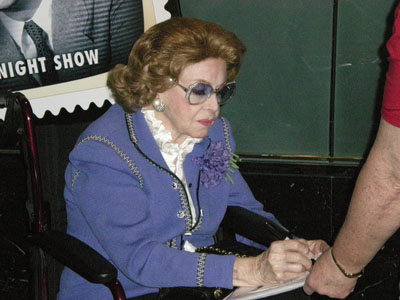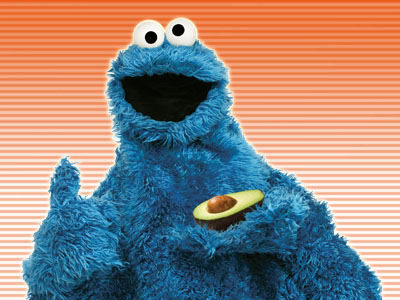
Moose and Squirrel
by Mark Evanier
ORIGINALLY PUBLISHED 6/23/00
Comics Buyer's Guide

Set the dials on the Waybac Machine, Sherman…
The date? November 19, 1959.
The place? Right in front of a very bad Packard-Bell TV set in Mark Evanier's parents' living room.
The Wayback Machine performs flawlessly, as it always does. Within seconds, we're standing in a modest dwelling in West Los Angeles, watching as a budding 7-year-old comedy/cartoon writer takes in the first episode of a brand-new animated television series. Its name? Rocky and His Friends. Each half-hour consists of two episodes of Rocky and Bullwinkle, and one apiece of Fractured Fairy Tales and Peabody's Improbable History.
And so it began…not just for me, but for a lot of us — our introduction to the wonderful world of Jay Ward (and Bill Scott and all the other splendid folks who conspired to create Jay Ward cartoons…)
Rocky was not the first TV cartoon with which the inventive Mr. Ward had been involved. I had been a big fan of Crusader Rabbit and even, at age seven, noted certain similarities between the series…
Both offered us serialized stories, told by a stentorian narrator.
Both starred a small, fur-covered hero who roamed the world with his big, dumb pal. Crusader's was Ragland T. Tiger; Rocky's was Bullwinkle J. Moose.
Both featured a recurring villain who popped up almost everywhere they want. Crusader and Rags kept running into Dudley Nightshade; Rocky and Bullwinkle battled Boris Badenov.
And both shows had slightly-askew senses of humor. The key difference was that Crusader Rabbit was funny, whereas Rocky and His Friends was FUNNY. Not only that but it was FUNNY in a very hip manner, never condescending to the viewers, never taking the easy route to something that kinda resembled a gag. As such, the shows would stand up to repeated viewings…and the more you saw them, the more jokes you'd get.
So it didn't matter much that, like all the early TV cartoons, the animation looked like it was done in the back room at Pic-and-Save. It never got much better, not even when the festivities trucked over to NBC and were aired in prime-time as The Bullwinkle Show.
The graphics were clever, the characters and scripts were brilliant and the voice acting was first-rate…maybe the best cast ever assembled for a cartoon show — June Foray, Bill Scott, Paul Frees, Daws Butler and William Conrad, with Edward Everett Horton as the Narrator of the Fractured Fairy Tales and Charlie Ruggles as Aesop, narrator of the Aesop and Son cartoons that were added later. (The Bullwinkle Show also introduced Dudley Do-Right, with Scott, Foray, Frees, occasionally Conrad and, in every installment, the glorious Hans Conried stealing the show as Snidely Whiplash.)
Of those folks, only June Foray is still with us. Matter of fact, we lost most of the men in a very short span of time: Hans Conried died in '82, Bill Scott in '85, Paul Frees in '86, Daws Butler in '88, Jay Ward in '89 and Bill Conrad in '94. The last time I saw some of these folks was at a funeral for another of these folks.
Happily though, June is around to reap the honors. On July 7, she will be honored when a star bearing her name is unveiled on the Hollywood Walk of Fame. And it's about damned time.
She'll also be getting loads of well-deserved attention as a new motion picture opens around then — Rocky and Bullwinkle, starring Robert DeNiro, Jason Alexander and Rene Russo. But of course, in this film, they're nobodies. The real star will be June Foray, performing the role of the animated Rocky the Flying Squirrel.
So, you may be wondering: Who's doing Bullwinkle's voice? The answer is that they found the perfect person, even though they had to go halfway around the world for him. His name is Keith Scott.
First off: Keith is not related in any way to Bill Scott. Bill was the original voice of Bullwinkle, Dudley Do-Right, Mr. Peabody, George of the Jungle and many others. He was also the show's head writer and co-producer and a very funny, brilliant gent.
Keith lives and works in Australia. American cartoons and radio shows were imported into his country and, at an early age, he fell in love with both and set his sights on a career in vocal acting. Around age 17, he wrote to Daws Butler in America. Daws was not only one of the best voice actors of all time but a steadfast encourager of new talent. He and Keith developed a back-and-forth tutor/protégé relationship, shipping letters and tapes between continents. Keith finally came to Los Angeles and not only met all the great voice artists but began to indulge a passion for research. His two main areas of interest were…
1. Cartoon Voice History. Only a tiny percentage of the actors in theatrical animation received credit, and most of them were Mel Blanc. While some of the other voices are easily identifiable, many are not…or weren't, until a number of animation buffs put their minds to it. Keith is one of us — and an especially valuable scholar, owing to his huge collection of (and knowledge of) old radio shows.
2. The Jay Ward Studio. Daws referred Keith to Bill Scott which, in turn, led to Keith interviewing darn near everyone who worked on the premises, as well as gaining access to old scripts, tapes, files…the works. He quickly became the world's foremost authority on the place and…well, let's cut directly to the plug:
Keith has spent years compiling a book that comes out any day now from St. Martin's Press. It's called The Moose That Roared: The Story of Jay Ward and Bill Scott. If you have even the slightest interest in its subject, you absolutely have to have it. And if you don't have even the slightest interest in its subject, you should.
Can I make myself any clearer?
Over the years, Keith honed his skills and became one of the most in-demand announcers and performers of character voices in Sydney, Australia. He has joined a select group that some call "second generation" voice actors, meaning that they replicate the sound of a classic character, once the original performer is deceased or otherwise unavailable.
In the U.S., we have reached the point where the majority of great animated characters are in such custody. Since Mel Blanc passed away, for instance, his menagerie of voices has been simulated by, among others, Joe Alaskey, Billy West, Greg Burson, Maurice LaMarche, Jeff Bergman, Neil Ross, Frank Welker, Mindy Segal, Bob Bergen, Frank Gorshin, Jim Cummings, Bill Farmer and (occasionally) Mel's son, Noel Blanc. By my count, six of those gents have spoken for Bugs at varying times, five for Foghorn Leghorn and so on.
This is not easy to do. A voice must not only be imitated but sustained. A lot of folks can sound like Bugs for a line or two, especially if repeating dialogue that Mel performed in a cartoon. It's a whole 'nother thing to sound like Bugs throughout a 4-hour recording session, running a full gamut of emotions, often with no identical Blanc example to use as a template.
(Another problem: No two employees of Time-Warner seem to agree on exactly what Bugs sounds like, since Mel changed over the years. So if you please one department head, you displease another.)
As you can see, a whole squadron has stepped into Mel's shoes, at least for cartoons recorded in Southern California. Down under, Keith pretty much has the hemisphere to himself. He does most of the recordings of Mel's characters — and Daws's and others — when they have to be recorded locally. I don't know if there have been any recordings of the Tasmanian Devil for Tasmania…but if there have been, Keith probably did them.
You've heard him up here, as well. Sometimes, they do it via what's called a phone patch…which means that Keith is in a studio in Australia, working for someone here in the states. On bigger jobs, they fly him in. We had lunch one day here in Hollywood when he'd just come from recording Popeye and Bluto for a ride at the Universal theme park in Florida.
And of course, they've flown him in several times to record the role of Bullwinkle (and also the Narrator) for the new Rocky and Bullwinkle feature. All the time he was studying the history of the studio, he was practicing its voices, honing his Moose Sound-alike. June Foray told me, "There are times with Keith when, if I just heard a recording without knowing who'd done it, I'd have sworn it was Bill." Can't imagine a better endorsement than that. (Keith, by the way, also did the Narrator in the George of the Jungle movie.)
When he's in L.A. and not recording, we get together and swap info on voice actors. He's been working with the U.S. expert on the topic, Hames Ware, and with the British authority, Graham Webb. (Graham, by the way, also has a fine book out, well worth your attention — The Animated Film Encyclopedia, published by McFarland.) They all hope someday to publish a reference volume that will identify as many voices as possible from American cartoons made for theatrical exhibition. I'm going to close this piece with some nuggets of info I jotted down after the last time Keith and I got together. Many of these were things I hadn't known 'til he told me…
Mel Blanc always recalled that his first WB cartoon job was as a drunken bull in Picador Porky. Not so. His first role was as a drunken tramp in that film. His first "star" role came about in Porky's Duck Hunt when he took over from Joe Dougherty as Porky's voice.
Blanc did Bugs from the start, all through the various prototype versions. One brief exception is Bugs' line, "Of course you know, this means war" in Porky's Hare Hunt. That one line was done by director-storyman Ben "Bugs" Hardaway. Hardaway later replaced Blanc as the voice of Woody Woodpecker.
Daws Butler's first cartoon was Little Rural Riding Hood, which was directed by Tex Avery for MGM in 1949. Daws did the George Sanders impression as the voice of the City Wolf while the Country Wolf was played by Pinto Colvig, who was best known as the original voices of Goofy (for Disney) and Bozo the Clown (on Capitol Records). The gangly Country Red was voiced by Colleen Collins who, among many other credits, played Queen Isabella on the classic comedy record, Stan Freberg Presents the United States of America.
In that cartoon and many of Tex's, the singing voice of the attractive Red Riding Hood was Imogene Lynn, a popular radio singer. Her voice track in Little Rural Riding Hood was a re-use from Swing Shift Cinderella.
Daws Butler's first WB cartoon was a 1952 Tweety and Sylvester film, Gift Wrapped.
Stan Freberg did his first voice recording for WB doing a Franklin Delano Roosevelt impression for a cartoon that was to be called For He's a Jolly Good Fala. (Fala was the name of F.D.R.'s dog.) The film was written and recorded but then the President passed away and the project was abandoned.
Freberg's first completed cartoon was the role of Junior Bear in Bugs Bunny Meets the Three Bears (1944). Mel Blanc did the Father Bear and Bea Benaderet played Mama Bear. Years later, when the Three Bears were revived for a series of cartoons, Billy Bletcher took over the role of the Father Bear.
In the first Hubie and Bertie cartoon, The Aristo-Cat, their voices were done by storymen Tedd Pierce and Michael Maltese. For the second, Trap-Happy Porky, Maltese was replaced by Freberg. In the third, Roughly Squeaking, Dick Nelson and Freberg did the honors. Eventually, Blanc and Freberg played Hubie and Bertie, though both sometimes did pick-up lines in the other's role.
All of the Goofy Gopher cartoons apparently feature Blanc and Freberg as Mac and Tosh. When Hubie, Bertie, Mac and Tosh turned up for brief interstitial segments on the 60's Bugs Bunny TV show, Blanc apparently did all the parts.
Storyman Tedd Pierce did the Bud Abbott imitation in A Tale of Two Kitties with Blanc providing the Lou Costello clone. Pierce was also the voice of the father in Quentin Quail, imitating the character of Daddy Snooks from the Baby Snooks radio show. Sara Berner played his daughter, an imitation of Fanny Brice in the Baby Snooks role.
Pierce provided the narration for Uncle Tom's Bungalow and was one of the two French chefs in French Rarebit. Blanc was the other.
John McLeish (aka John Ployardt) narrated Chuck Jones's The Dover Boys. Blanc and Pierce did the voices of the Dover Boys, and the glee club's singing was by the vocal group, The Sportsmen.
McLeish narrated The Ducktators, which features Michael Maltese as Mussolini and Blanc as both Hitler and Hirohito.
Animator Dick Bickenbach did the Bing Crosby imitation in Swooner Crooner. ("Bic," as everyone called him, later drew many of the Flintstones and Yogi Bear comic books of the 70's.)
Tex Avery turns up in bit parts in many of his cartoons and occasionally in those of other directors. Tex's biggest part was the Laughing Hippo in Hamateur Night.
The spider character in Meatless Flyday was inspired by an Avery voice and he often said that he'd done the part, even though he had left WB by the time this cartoon was recorded. He may have recorded the role but the voice in the finished cartoon is that of Cy Kendall.
Several published reports have fingered singer Terrence Monck as the voice of the frog in Chuck Jones's One Froggy Evening. This was apparently someone's deduction based on the job Monck did many years later for Jones on an MGM cartoon. It was actually Bill Roberts, a studio singer of the day. Monck also has been wrongly credited as the opera singer who keeps Bugs awake in Long-Haired Hare. That was actually Nicolai Shutorov. (And while we're at it, Carlos Ramirez was the opera singer in Tex Avery's Magical Maestro for MGM.)
Okay, that's all I have room for this week, so let me summarize your assignments…
1. Pick up Keith's book, The Moose That Roared: The Story of Jay Ward and Bill Scott.
2. When you go see the Rocky and Bullwinkle movie, listen especially to June Foray as Rocky and Keith Scott as Bullwinkle.
3. Be here next week when I hope to provide a preview of some splendid panels that will take place at this year's Comic-Con International in San Diego.
That is all.


